
Background information
The big monitor preview 2024
by Samuel Buchmann

As the first monitor with a second generation WOLED panel, the Asus PG34WCDM promises more brightness and less motion blur. Can it set itself apart from the QD-OLED competition and justify its high price?
A gaming monitor in 21:9 format with an OLED display. «BOOOOORING», I hear some of you shout. «We’ve had this stuff for ages.»
True, but the Asus ROG Swift PG34WCDM is different. All previous monitors of this type have one thing in common – a QD-OLED panel from Samsung. The PG34WCDM is the first to have a WOLED panel from LG. It’s the first screen ever to feature the second generation of these panels. You’ll find more background information on that here:
The LG panel differs from its QD-OLED rivals with aggressive curvature, a matt coating and a higher frame rate, among other things. The official key data of the Asus PG34WCDM at a glance:
The new monitor is exciting, but is it good? I put it through its paces. I now have the same professional measurement technology at my disposal that my colleague Luca already uses for TVs. I even extend its use case to monitor reviews.
Manufacturers of gaming monitors all seem to agree – their devices have to look futuristic and somehow light up. The Asus PG34WCDM would also be suitable as a prop for a sci-fi movie. Its three-legged stand projects the logo onto my table like a UFO. The back of the monitor is illuminated by RGB.
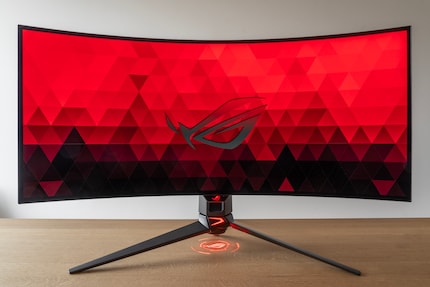
I don’t like all these bells and whistles. Luckily, all lighting effects can be deactivated. After doing so, the Asus PG34WCDM actually looks quite okay. The housing is made of black plastic and the base is an anthracite-like metal. Its floating design has the advantage that docking stations and external hard disks will fit under the monitor. To make that happen, the base’s rear leg extends so far back that there’s at least 20 centimetres between the edge of the table and the screen.
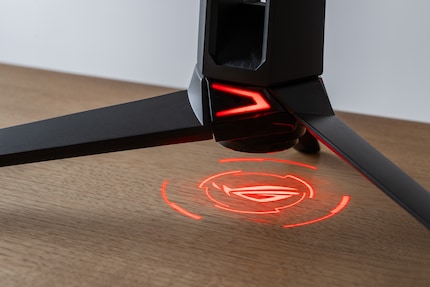
There’s nothing to complain about in terms of quality – just like the stability of the monitor. It barely shakes when I bump into the table. The ergonomics are also perfect – I can adjust the height, tilt and rotate the PG34WCDM. The range of connections for signal transmission is sensible. Two HDMI 2.1 ports, one DisplayPort 1.4 and one USB-C should cover almost all devices. The latter supplies up to 90 watts of power. There are also three USB-A ports and a headphone jack at the top, bottom and rear – USB-C ports for peripherals are unfortunately missing.
The following is a deep dive into the subject matter. Measurements with professional tools from Portrait Display allow an objective classification of image quality. If you aren’t interested in details and diagrams, you can read the short version then scroll to the Gaming section.
My most important findings in brief:
The Asus PG34WCDM features a new WOLED panel from LG. It shines brighter than older generations – I measure a maximum full-screen brightness of 265 nits. This roughly corresponds to the current QD-OLED competition, but is far below the values achieved by LED screens.
With less white content, Asus allows up to 432 nits in the standard setting. This makes the monitor appear brighter in games or videos. However, the variable brightness can be distracting at work. The Uniform Brightness option fixes this. It limits the maximum brightness to 260 nits across the board and works very well.
As with all OLED monitors, the contrast value tends towards infinity because each individual pixel can be switched off. The PG34WCDM is also evenly illuminated, with a maximum DeltaE of 1.6 between the centre and corners.
The question that arises with high brightness: is there a greater risk of burn-in? After all, the higher the brightness, the greater the energy draw. More heat is generated, which risks burn-in. WOLED technology needs more juice than QD-OLED to achieve the same brightness. Asus tries to counteract the heat with a passive heat sink. It’s impossible to say how effective it is without a long-term test. Still, Asus offers a two-year burn-in warranty. Nice. But what makes me suspicious: QD-OLED devices are three years old at this point.
The Asus PG34WCDM has a matt coating, whereas previous monitors with QD-OLED have a mirror finish. WOLED panels also don’t reflect ambient light as strongly. All in all, this means that the Asus PG34WCDM looks crisper than the competition in a bright room. Black doesn’t become dark grey, reflections aren’t a factor in dark rooms. As a result, mirrored QD-OLED models look better. So, both variants have pros and cons.
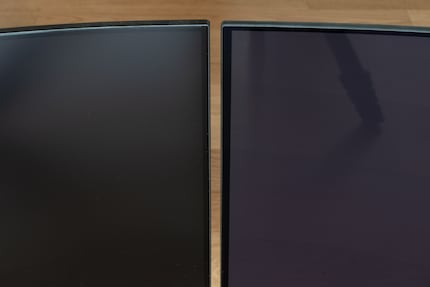
Measuring colours and shades of grey is intended to answer three questions:
The gamma values of dark and medium grey tones are close to the target value of 2.2. Only the lightest tones are displayed too brightly, with a few details lost. The white balance of my test model is extremely accurate – there’s no visible colour cast. The average DeltaE of 0.6 is outstanding.
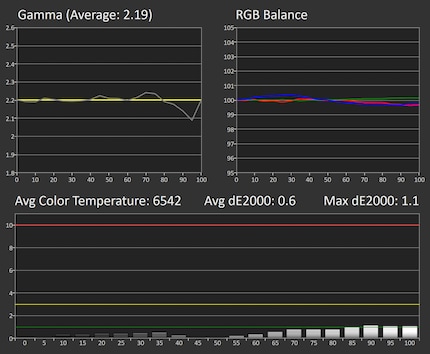
The Asus PG34WCDM covers the common SDR colour spaces very well:
The colour accuracy in standard picture mode isn’t as good with sRGB content. Here, the main problem is excessive saturation. As a result, images and videos online look brighter than they should – a common problem with wide-gamut monitors.
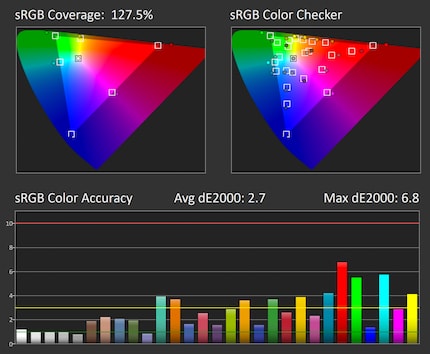
Luckily, the Asus PG34WCDM has an sRGB picture mode that solves the problem. This limits the colour space and thus eliminates excessive saturation, reducing deviations in colour accuracy to a minimum. This setting is highly recommended for SDR content.
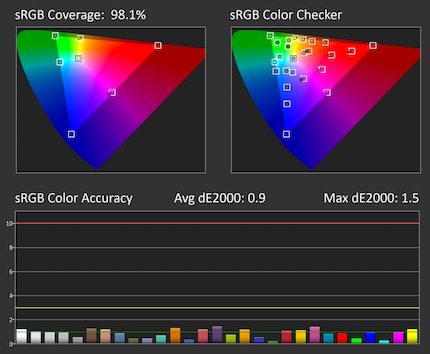
More and more games support HDR, so monitor manufacturers are increasingly designing their high-end devices with this in mind. However, many displays can’t display colour and brightness values accurately. Deviations here are generally greater than with SDR content. This is also the case with the Asus PG34WCDM, although it performs well in comparison to other devices.
Its EOTF and luminance curves approximately follow target values. Dark tonal values are displayed somewhat too brightly. I think that’s better than the other way around, that way no details are lost. In HDR mode, the white balance drifts into blue with light-grey tones. However, the maximum DeltaE of 2.7 is still perfectly acceptable.
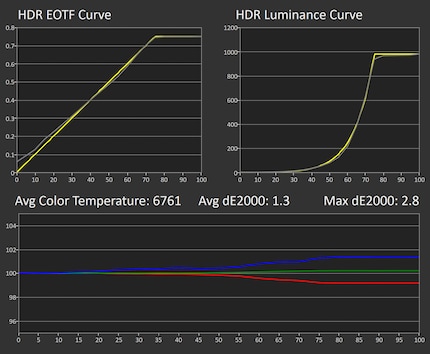
I measure the coverage of HDR colour spaces:
This suboptimal coverage of BT.2020 is typical for WOLED panels. Only QD-OLEDs can display the bright and simultaneously rich red, yellow and green tones required for this colour space. This can be seen in the poor HDR colour accuracy of the Asus PG34WCDM when I take the luminance error into account. After doing so, the maximum DeltaE is a very high 17.4.
Not so bad in practice – almost all content today is still calibrated for DCI-P3. This colour space is almost completely covered, the colour accuracy without luminance errors is also suitable with a maximum DeltaE of 3.2.
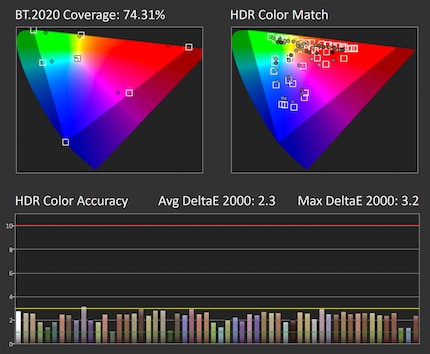
Gaming is the Asus PG34WCDM’s specialty. Its format should suit many. The 21:9 aspect ratio is wide, but not too wide. 34 inches is big, but not huge. The only thing I find too aggressive is the 800R curve, but that’s a matter of taste. Its 1440p resolution hits a sweet spot between enough detail and high frame rates for many systems. After all, up to 240 frames per second (FPS) are possible with this monitor.
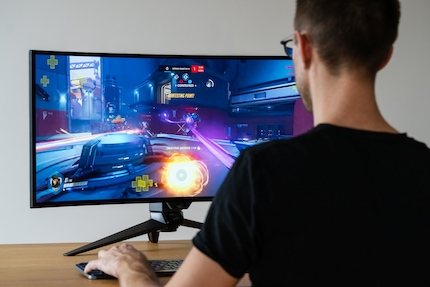
Thanks to 240 Hertz and OLED technology, the monitor is ideal for fast-paced games such as shooters – response times are excellent. Objects in motion remain very sharp at a full frame rate.
Asus also has a trick up its sleeve if your PC doesn’t manage 240 FPS in a game. If you set the frame rate to 120 Hertz, the monitor can insert a black image between each frame. Here, motion blur will remain as low as with 240 Hertz. However, this halves the maximum brightness. Asus calls this option Extreme Low Motion Blur (ELMB).
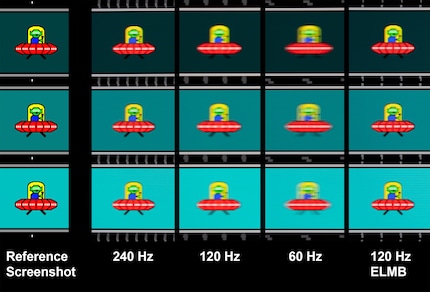
All these good values mean that gaming on the Asus PG34WCDM is a lot of fun, whether in role-playing games or shooters, in SDR or HDR. The monitor is one of the best you can buy in this format. However, only the matt coating, the slightly higher frame rate and the better HDR accuracy set it apart from models with a QD-OLED panel.
Away from games, the Asus PG34WCDM doesn’t cut a particularly good figure. The WOLED panel has decisive drawbacks here.
First among these is the risk of burn-in. For my review, I worked on my test device for several weeks – at high brightness and with static elements such as menu bars. I leave all protective measures switched on. After three weeks, I can still see disturbingly clear ghost images of the Apple logo and the edges of the window in the grey control image. Luckily, they disappear again after pixel cleaning the monitor. But will that still be the case after a few years?
The second disadvantage is that text sharpness is poorer than on LCD monitors. Firstly, this is due to the mediocre pixel density of 110 pixels per inch. Secondly, the subpixel pattern deviates from the established layout of operating systems. The WOLED panel uses an RWBG layout, whereas classic LCDs use RGB. This results in colour fringing at high-contrast edges, as Windows and macOS don’t optimise content for this pattern. These colour fringes aren’t explicitly visible from a normal distance, but make things like text appear less sharp.
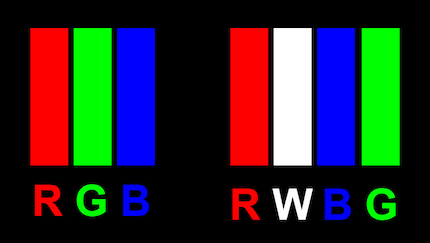
Asus is trying to reduce the problem at a firmware level with an option called Clear Pixel Edge. It doesn’t really work. Although colour fringing is reduced for large fonts, small text appears even more blurred. Subjectively, even first-generation QD-OLED panels, which also have a suboptimal triangular subpixel pattern, seem sharper to me.

The monitor has an Auto Static Brightness Limiter (ASBL). If image content changes little, brightness will be reduced after a few minutes. It only rises again when I move a window. That can be quite annoying when I’m writing an article, for example. Unlike other screens, I can fortunately deactivate ASBL (Asus calls it Screen Saver).
I find the operating concept and option selection exemplary. I can control the monitor using a joystick or software. Menus are logically structured and all options are available independently of each other. For example, I can select the sRGB colour space, but still change the colour temperature or brightness. This isn’t possible with many monitors.
The Asus PG34WCDM quickly goes into standby mode when I switch off the computer – and reliably wakes up again as soon as it receives a signal. It also works with Macs without any problems. There were no bugs at all during my test.
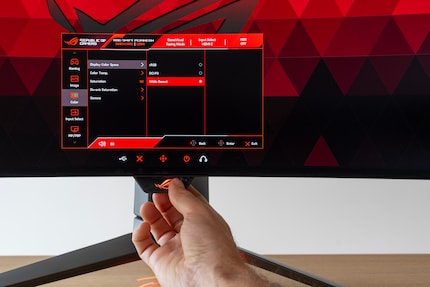
In everyday life, I measure an average energy requirement of around 50 watts at 80 per cent brightness. At full brightness in HDR mode, this rises to 70 watts, while bright scenes can sometimes require over 100 watts. These values correspond to other OLED monitors of this size. LCDs with LED backlighting consume significantly less power.
The Asus PG34WCDM is a premium monitor that really comes into its own in games. The combination of OLED and 240 hertz allows nearly no motion blur. The 1440p resolution is only average, but you can achieve good frame rates even without a high-end graphics card.
The new WOLED panel catches up with QD-OLED – even during the day it’s bright enough, partly because of the matt coating. White balance, colour space coverage and colour accuracy are excellent for a gaming monitor. The picture looks rich, but not unnatural – even in HDR mode, which is well balanced. It doesn’t swallow up any details in shadows and can display highlights with up to 1,000 nits.
I can’t recommend this screen for office use. Text sharpness is poor due to the mediocre pixel density and the special sub-pixel pattern. In addition, the risk of burn-in with static content seems too high to me.
However, the biggest problem with the PG34WCDM is its price. It currently costs 500 francs more than the Alienware AW3423DWF and other models with a QD-OLED panel – without any significant advantages. If your budget’s that big, you probably have a high-end PC under your desk, in which case you’re better off with one of the new 4K OLEDs. The first review will follow soon.
Pro
Contra
My fingerprint often changes so drastically that my MacBook doesn't recognise it anymore. The reason? If I'm not clinging to a monitor or camera, I'm probably clinging to a rockface by the tips of my fingers.